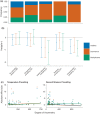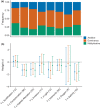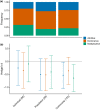Local stressors mask the effects of warming in freshwater ecosystems
- PMID: 36161435
- PMCID: PMC9826496
- DOI: 10.1111/ele.14108
Local stressors mask the effects of warming in freshwater ecosystems
Abstract
Climate warming is a ubiquitous stressor in freshwater ecosystems, yet its interactive effects with other stressors are poorly understood. We address this knowledge gap by testing the ability of three contrasting null models to predict the joint impacts of warming and a range of other aquatic stressors using a new database of 296 experimental combinations. Despite concerns that stressors will interact to cause synergisms, we found that net impacts were usually best explained by the effect of the stronger stressor alone (the dominance null model), especially if this stressor was a local disturbance associated with human land use. Prediction accuracy depended on stressor identity and how asymmetric stressors were in the magnitude of their effects. These findings suggest we can effectively predict the impacts of multiple stressors by focusing on the stronger stressor, as habitat alteration, nutrients and contamination often override the biological consequences of higher temperatures in freshwater ecosystems.
Keywords: antagonisms; aquatic ecology; dominance null model; global change; multiple stressors; stressor interactions.
© 2022 The Authors. Ecology Letters published by John Wiley & Sons Ltd.
Figures





References
-
- Ban, S.S. , Graham, N.A.J. & Connolly, S.R. (2014) Evidence for multiple stressor interactions and effects on coral reefs. Global Change Biology, 20, 681–697. - PubMed
-
- Bancroft, B.A. , Baker, N.J. & Blaustein, A.R. (2008) A meta‐analysis of the effects of ultraviolet B radiation and its synergistic interactions with pH, contaminants, and disease on amphibian survival. Conservation Biology, 22, 987–996. - PubMed
-
- Birk, S. , Chapman, D. , Carvalho, L. , Spears, B.M. , Andersen, H.E. , Argillier, C. et al. (2020) Impacts of multiple stressors on freshwater biota across spatial scales and ecosystems. Nature Ecology & Evolution, 4(8), 1060–1068. - PubMed
-
- Boyd, P.W. , Collins, S. , Dupont, S. , Fabricius, K. , Gattuso, J.‐P. , Havenhand, J. et al. (2018) Experimental strategies to assess the biological ramifications of multiple drivers of global ocean change—a review. Global Change Biology, 24, 2239–2261. - PubMed
-
- Brooks, P.R. & Crowe, T.P. (2018) Density and biotic interactions modify the combined effects of global and local stressors. Oikos, 127, 1746–1758.
Publication types
MeSH terms
Grants and funding
LinkOut - more resources
Full Text Sources
Miscellaneous

